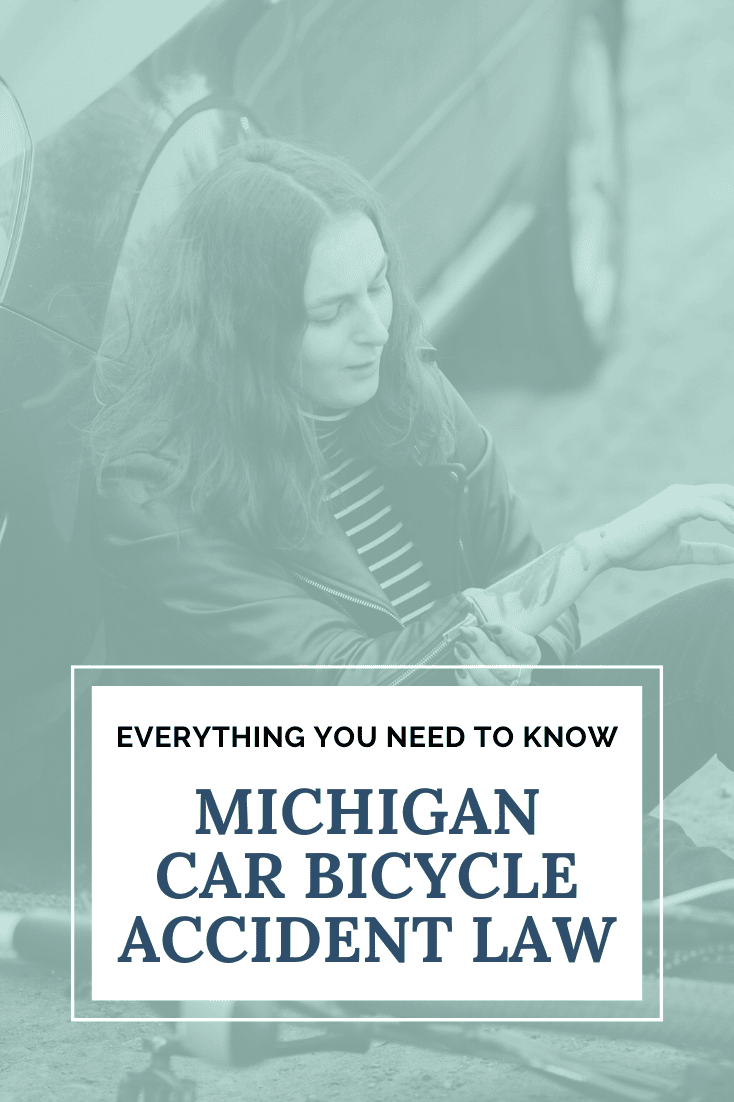Michigan Car Bicycle Accident Law: Everything You Need To Know

Under the Michigan car bicycle accident law, injured bicyclists may recover pain and suffering compensation as well as excess medical expenses, excess lost wages, and other economic damages from the at-fault driver of the vehicle who caused the crash. No-Fault benefits may also be recovered.
The Michigan car bicycle accident law also outlaws certain driving behaviors that can injure bicyclists.
Pain and suffering compensation
The Michigan car bicycle accident law provides that an injured bicyclist may recover pain and suffering damages from the at-fault driver of the vehicle who caused the crash. However, the bicyclist must show he or she suffered a “serious impairment of body function” as a result of his or her injuries.
Under the Michigan car bicycle accident law, an injured bicyclist may also be able to recover excess medical expenses and excess lost wages from the at-fault driver to cover those medical bills and wages whose amounts exceed what is covered under the applicable auto insurance policy and/or what is guaranteed to injured bicyclists under the No-Fault law.
Wrongful death damages
The dependents and family of a bicyclist who was killed in a crash may be able file a wrongful death lawsuit against the at-fault driver who caused the crash. Damages awarded may include compensation for the bicyclist’s pain and suffering and his or her dependents’ loss of financial support and loss of society and companionship.
Liability insurance coverage under the Michigan car bicycle accident law
The liability insurance coverage of the at-fault driver of the vehicle who caused the crash that injured a bicyclist will help to pay for the pain and suffering compensation and excess medical expenses and lost wages that the at-fault driver is ultimately determined to be liable for.
Generally, Michigan law requires all Michigan drivers to carry liability insurance coverage with the following minimum limits:
- “[N]ot less than $250,000.00 because of bodily injury to or death of 1 person in any 1 accident.” (MCL 500.3101(1); 500.3131(2); 500.3009(1)(a))
- “[N]ot less than $500,000.00 because of bodily injury to or death of 2 or more persons in any 1 accident.” (MCL 500.3101(1); 500.3131(2); 500.3009(1)(b))
The law also provides that a driver “may choose to purchase lower limits” of $50,000 and $100,000. (MCL 500.3009(5)
If the vehicle being driven by the at-fault driver who injured the bicyclist was an Uber or Lyft or a truck or commercial vehicle, then the liability insurance coverage limits may be higher.
Rules to protect bicyclists under the Michigan car bicycle accident law
Below are some of the most common driving behaviors that result in drivers being determined to be at-fault for causing the crash:
- Failing to yield the right-of-way to traffic from a different highway in intersections (MCL 257.649)
- Failing to yield the right-of-way when turning left in an intersection, which often takes the form of turning in front of bicyclists as they are lawfully going straight forward (MCL 257.650)
- Failing to stop/yield the right-of-way when leaving a private drive (MCL 257.652)
- Disobeying a stop, yield or merge sign (MCL 257.671(3))
- Disregarding traffic control signals – including flashing red and yellow signals (MCL 257.612 and 257.614)
- Speeding in violation of the posted speed limit (MCL 257.627 and 257.628)
- Driving too fast for conditions (MCL 257.627(1))(Under the Michigan car bicycle accident law “A person operating a vehicle on a highway shall operate that vehicle at a careful and prudent speed not greater than nor less than is reasonable and proper, having due regard to the traffic, surface, and width of the highway and of any other condition existing at the time.”)
- Driving too fast to be able to stop safely (MCL 257.627(1))(“A person shall not operate a vehicle upon a highway at a speed greater than that which will permit a stop within the assured, clear distance ahead.”)
- Overtaking or passing a bicyclist at an unsafe distance (MCL 257.636(2) requires that a motorist who is overtaking or passing a bicyclist traveling in the same direction “shall pass at a safe distance of at least 3 feet to the left of that bicycle.”)
- Opening a vehicle door into a bicyclist’s path
- Driving while distracted (See Michigan’s texting ban in MCL 257.602b)
- Driving while intoxicated (MCL 257.625)
- Reckless driving (MCL 257.626)
- Careless driving (MCL 257.626b)
- Driving and/or parking in a designated, marked bike lane
No-Fault benefits under the Michigan car bicycle accident law
An injured bicyclist can recover No-Fault PIP benefits (which are also called “personal injury protection” benefits) that will help pay for the bicyclist’s medical bills, lost wages (if he or she is disabled from working), transportation costs for traveling to and from doctor appointments as well as household replacement services and attendant care services.
To recover No-Fault benefits, the law requires an injured bicyclist to file an application for No-Fault benefits – which is also called a “written notice of injury” – with the responsible auto insurance company within one (1) year after the crash. (MCL 500.3145(1) and (4))
Failure to timely file the application will forever disqualify the injured bicyclist from claiming and recovering any and all of the No-Fault benefits he or she would have otherwise been entitled to.
Michigan car bicycle accident law determines what insurance company pays No-Fault benefits
Under the law, an injured bicyclist will recover his or her No-Fault benefits from his or her auto insurance company, the insurer for his or her spouse or a resident relative or through the Michigan Assigned Claims Plan. (MCL 500.3114(1) and 500.3115)
The Michigan Assigned Claims Plan assigns companies to handle No-Fault claims for people injured in crashes who have no other source of No-Fault coverage.
Call Michigan Auto Law for a free consultation
If you are a bicyclist and you have been injured in a bike vehicle crash, you can call toll free anytime 24/7 at (800) 968-1001 for a free consultation with one of our experienced automobile crash attorneys to discuss your rights under the Michigan car bicycle accident law. You can also get help from an experienced accident attorney by visiting our contact page or you can use the chat feature on our website.






